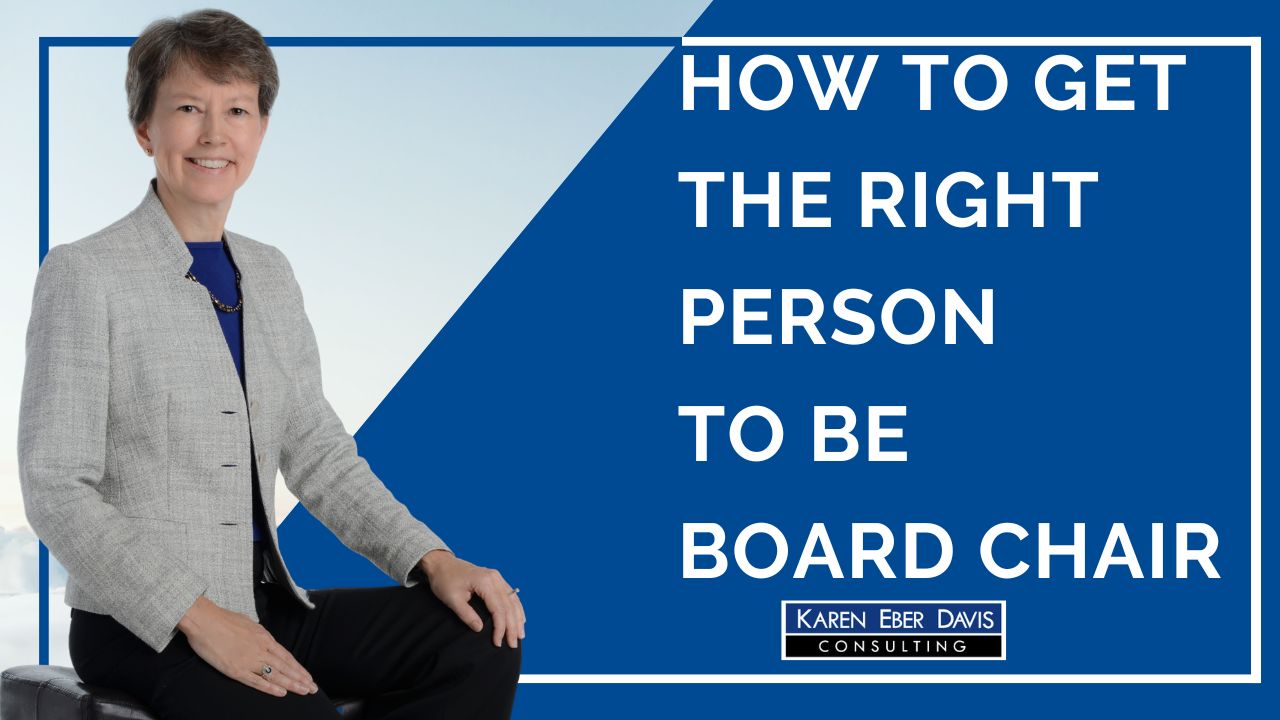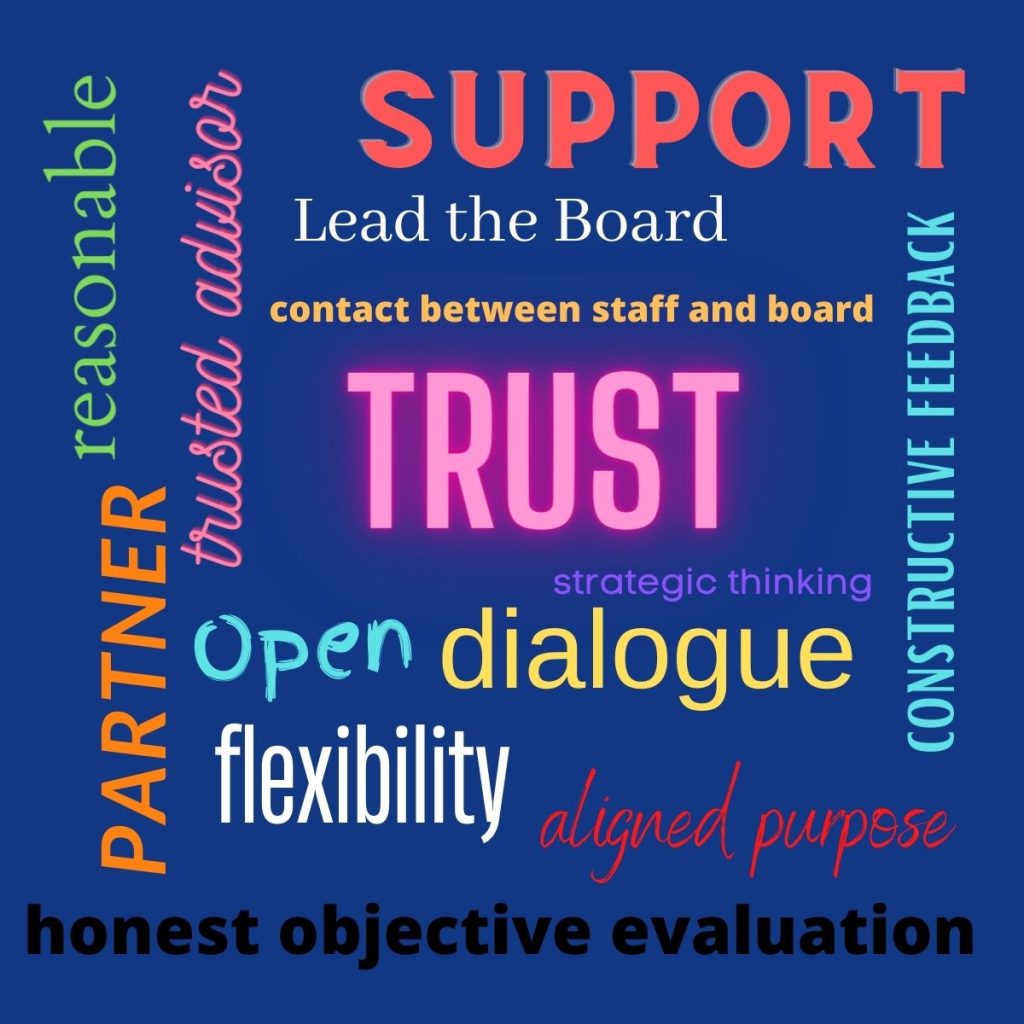
How to Get the Right Person to Be Board Chair
How can you get the right person to be the board chair? –since the wrong board chair makes your life as a nonprofit CEO miserable.
It’s not only hard to find the right person. You need to get them to say yes. Who can blame them for turning you down? Being a board chair is a lot of work and responsibility. And it carries risks from external and internal events–no matter how unlikely.
Stay tuned for three paths to getting the right person. As you watch, pick your favorites to begin today.
Transcript for How to Get the Right Person to be Board Chair
How can you get the right person to be the board chair? After all, the wrong board chair makes the life of a nonprofit CEO pretty miserable. And being a board chair is a lot of work and responsibility, and it always carries some unknowns and risks. Here’s what I’ve learned guiding my clients in this area and the three pathways that make the most dramatic differences.
#1 Reduce the Job’s Scope
You want to lighten the load of the board chair so that there’s not so much on his or her back. So, here are some examples of that—what would that look like?
For one, the CEO Evaluation: The board chair may not be part of that subcommittee. Instead, they are just interviewed.
Number two, the Vice Chair
Instead of only picking up the meetings and meeting leadership when the board chair is not available, do it quarterly.
Number Three, Seek Continuous Improvement
Ask how we can lighten this load. Are you doing the essentials, or what else have you picked up? How have we made this job via catch-all? And continuously work to refine it so that the board chair does the essentials.
What’s the result of this? You have a job description that is not so overwhelming, and instead of a hero, you just need a dedicated leader
#2 Create Chair “Career” Pathways
The second pathway is to design and think about what the board chair degree would be at your nonprofit. This is sort of like succession planning. Only I think of it as succession doing.
And so the way you would do this is a couple of things.
First, you would set the expectations with the board and individual board members. “Hey, great that you’re here, but by the way, part of what we do is help every board member be able to move into some leadership roles on the board.
Secondly, is to develop a curriculum. [Here’s an example board orientation curriculum.] What’s required to be a board chair? And what would happen if you were taking a college degree on becoming a board chair? What would happen in the first semester? What were the required courses? Second, third, fourth, etc. So the idea is that you were vetting and getting people through certain experiences so that when they’re a board chair, they know what it’s like to be on a committee or know what this group does, giving them deep knowledge. (See the word cloud for words nonprofit CEOs use to describe successful CEO-Board Chair Relationships)
The third way to do this is when you’re making assignments or inviting people, you’re thinking in terms of how do we get people to have the experiences they need so that they can be a board chair or another significant leadership position inside of the board.

What happens when you do this? When you think about the board degree is, you have a collection of vetted leaders who are ready to take on the nonprofit leadership responsibility. It lightens everyone’s load. Everyone is learning together.
# 3 Reduce Relationship Unknowns
The Third Pathway to getting the right board chair is to develop the relationships in advance. How can you do this well? Having one-on-one coffees with all your board members, ideally quarterly, but maybe once a year. Start off with half of them this year. Whatever you do, get started. One-on-one coffees can be online, but it’s the one-on-one conversation where you find out what’s going on with them. What do they need?
Secondly, as you work with people, have some ground rules. And discuss what rules you’ll follow. You don’t want any surprises is a classic one. That no one will surprise each other, that you will stay in touch, and then also you’re going to do a quick evaluation post-meeting.
A third way to do this is to get the relationships going is to take notes. Who actually does what? What do they say? And, express? You think you’re going to remember this. You’ll get the gist in your heart and your gut. But you’ll find it really helpful to take notes to remember. “Oh, so and so said that they love this and never showed up on this other activity.” Good to have that in a place. As you develop relationships, you know what people will and won’t do.
So there you have it, three pathways to get the board chair that you want and need and that your organization deserves. One: drill down. Make sure that the job description is not overwhelming. (Here’s a terrific checklist by Joan Garry to give to your candidate to make sure the yes is real yes.) Number two: create the board chair degree. Number three: build your relationships beforehand. Which of these three is your favorite? And more importantly, what activity from this video will you do today? Go ahead and put your comments in the notes below.
Karen Eber Davis is a nonprofit strategic planning consultant who works with visionary leaders committed to taking their organizations to new heights. She offers customized strategies, assessments, and coaching designed to help leaders lead their organizations to achieve their potential. She is the author of 7 Nonprofit Income Streams and Let's Raise Nonprofit Millions Together.
Categories
If you appreciate these Added Value posts, please consider subscribing.
Latest Posts
- How New Nonprofit CEOs Secure Board Buy-In for Strategic Planning
- How Nonprofit Leader Navigate Crisis with Clarity & Confidence
- One Way AI Can Help You Find a Path Where None Exists
- In Crisis? Resist Cutting Your Ability to Make Income
- Nonprofit Strategic Planning Assessment: 10 Questions to Strengthen Your Strategy
